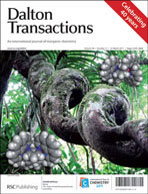The electrosynthesis of Rh2(dpf)4(R) where dpf is the N,N′-diphenylformamidinate anion and R = CH3, C2H5, C3H7, C4H9 or C5H11 was carried out in THF containing 0.2 M tetra-n-butylammonium perchlorate (TBAP) and one of several alkyl iodides represented as RI. The initial step in the reaction involved a one-electron reduction of the Rh24+ unit in Rh2(dpf)4 to its Rh23+ form followed by a homogeneous reaction involving electrogenerated [Rh2(dpf)4]− and the alkyl iodide in solution to give Rh2(dpf)4(R). The homogeneously generated Rh25+ product was then immediately reduced by a second electron at the potential where [Rh2(dpf)4(R)]− is generated, giving [Rh2(dpf)4(R)]− which contains a Rh24+ center as a final product of an electrochemical ECE mechanism. The electrosynthesized [Rh2(dpf)4(CH3)]− derivative could be reoxidized to Rh2(dpf)4(CH3) on the reverse potential sweep and both forms of the CH3 bonded derivative were in situ characterized by cyclic voltammetry combined with UV-visible and/or ESR spectroscopy. The reversible Rh24+/3+ process of Rh2(dpf)4 is located at E1/2 = −1.11 V in THF, 0.2 M TBAP while the electrogenerated Rh2(dpf)4(R) products are substantially easier to reduce, with Ep values for the Rh25+/4+ couples ranging from −0.50 to −0.54 V vs.SCE depending upon the specific R group.

You have access to this article
 Please wait while we load your content...
Something went wrong. Try again?
Please wait while we load your content...
Something went wrong. Try again?


 Please wait while we load your content...
Please wait while we load your content...